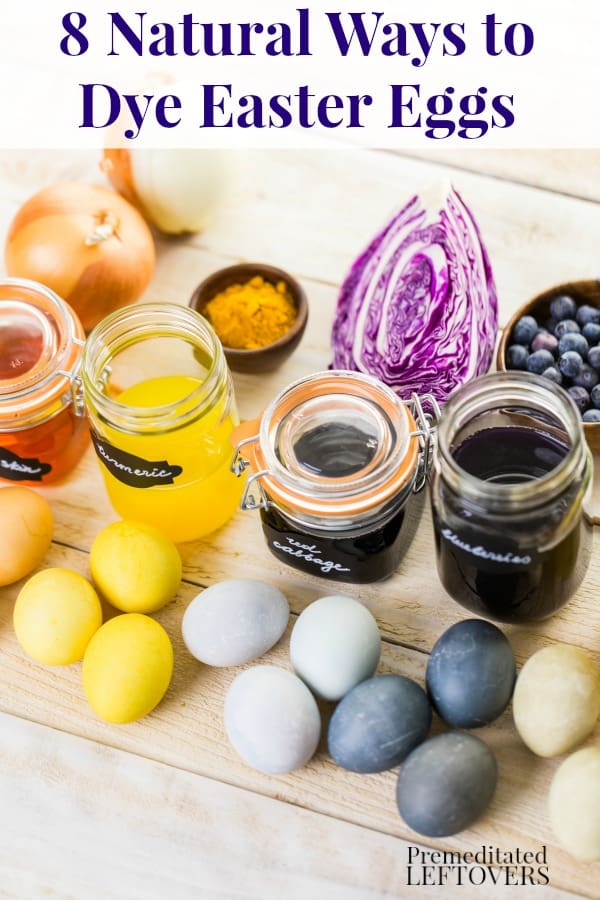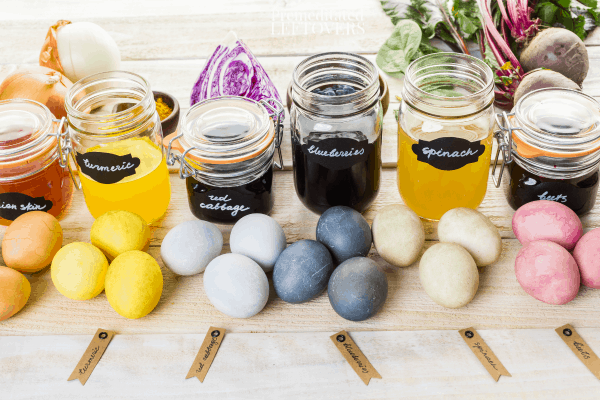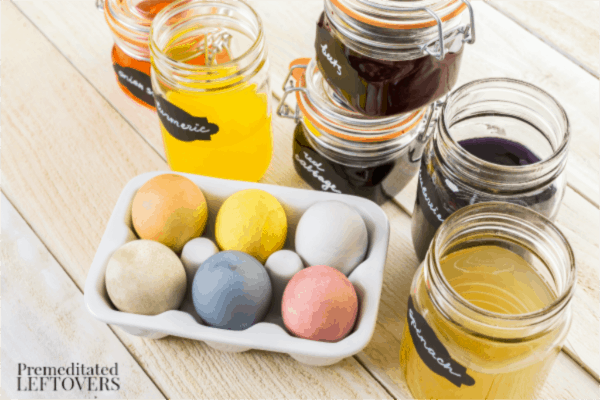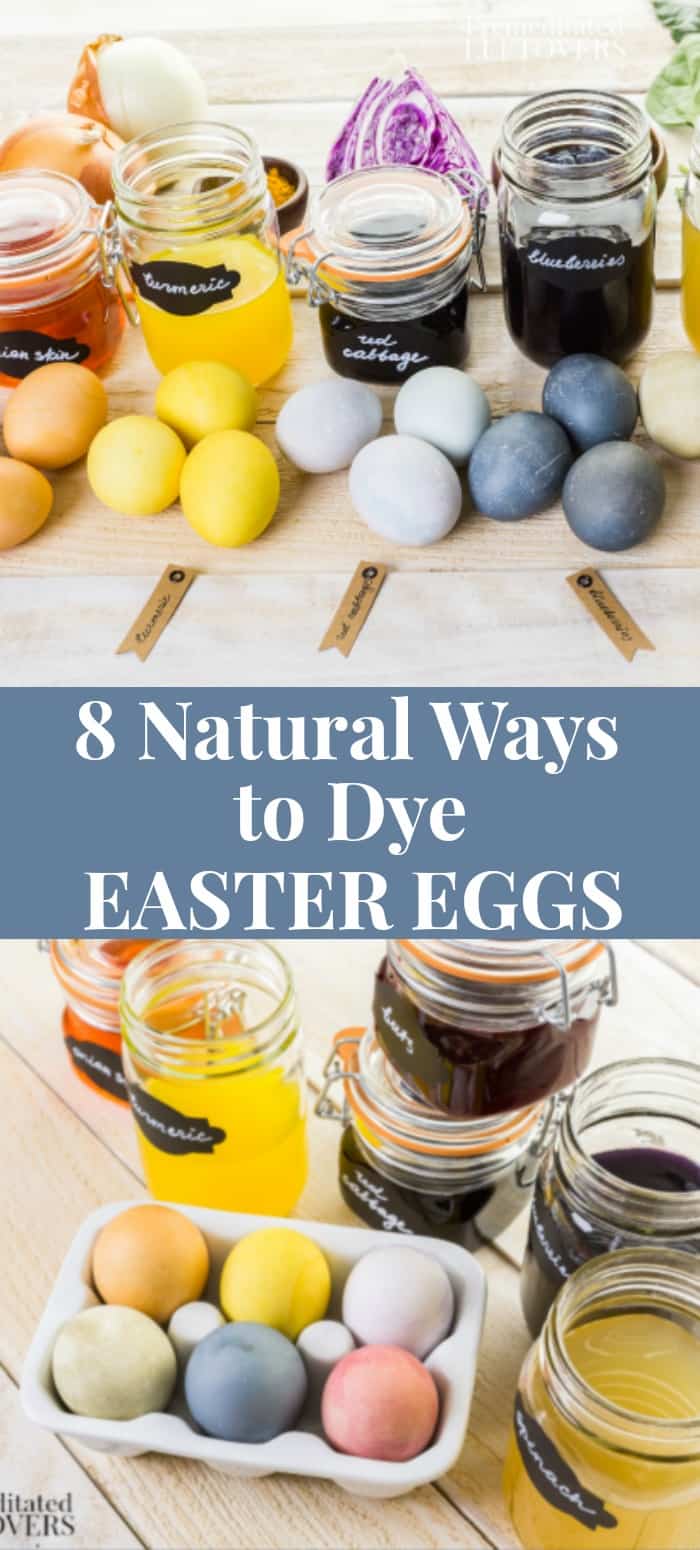Here are 8 natural ways to dye Easter Eggs using fruits, vegetables, spices, and tea.
Did you know that there are plenty of items right in your own kitchen that can be used to dye Easter eggs? If you want a more natural approach to your Easter egg coloring this year, take a look below at some helpful suggestions to get you started. You will find 5 ways to dye Easter eggs naturally and inexpensively. This is a fun, frugal, and green approach to the Easter season that you will want to try, so take a look!
Tips for Naturally Dying Easter Eggs
Lay down newspaper to catch any drips. While these dyes are natural and safe, they will stain items they come in contact with.
Use glass jars, glass or metal bowls, or pots to dye your eggs, so that you don’t stain your dishes while you are staining your eggs.
For each of the below methods for naturally dying Easter Eggs, you will want to let the eggs sit in the dye for at least 30 minutes to get a lovely color. You can allow the eggs to stay in the dye longer if you wish. The longer they sit, the deeper the color will be.
8 Natural Ways to Dye Easter Eggs
Choose one or several of the below methods to naturally dye Easter Eggs. If you wish to dye all of your eggs one color double, triple or quadruple the dye to make a large batch and dye all of your eggs in one pot or bowl.
1. Turmeric
Turmeric will offer your eggs a bright yellow hue that is deep and rich. Add a tablespoon of turmeric. to a cup of water along with a tablespoon of white vinegar. Soak your eggs in the mixture for several minutes until they are the color you want. Just be careful, as this mixture will stain fingers for several days. It is a strong one!
2. Paprika
Want some orange eggs? Then use paprika! Add a tablespoon of paprika to a cup of warm water and a tablespoon of vinegar as you did above. Mix the solution well and soak your eggs in it for several minutes. The longer you soak them, the darker and richer the color will be.
3. Dill Seeds
While you might think dill seeds would give you green eggs, they actually give you brownish gold eggs. This is a great color if you are after a neutral and natural look. Soak a few tablespoons of dill seeds in a cup of warm water, add a tablespoon of vinegar, and you are all set. If you wish to strain the seeds prior to coloring you can.
4. Fruit juice
Get lovely hues of violet, pink, and red when you use fruit juice to color your eggs. Pour grape, cherry, or blueberry juice in a mug with a splash of vinegar and you will have some of the prettiest eggs around. Fruit juice offers lovely hues and does so in just minutes. Use 1 tablespoon of vinegar of each cup of juice.
5. Green tea
Green tea powder can be found at most health markets and offers your eggs a light green hue. Soak the power (about a teaspoon will do) in a cup of warm water and in no time your eggs will be minty green.
6. Onion
To create orangish eggs, dye them with onion skins. Use onion skins from about 6 yellow onions. Add them to a pot with 3 cups of water and 2 tablespoons of vinegar. Bring them to a boil, reduce the heat and simmer on low for 20 minutes. Allow the mixture to cool. Strain off the skins and use the remaining liquid to dye the eggs.
7. Red Cabbage
Red cabbage creates blue Easter eggs. How dark the color depends on how long you leave them in the dye. Chop up a half a head of cabbage and add it to a pot. Add enough water to cover the cabbage and 2 tablespoons of vinegar. Bring it to a boil. Then lower the temperature and simmer for 30 minutes. Allow the mixture to cool. Then strain out the cabbage and use the liquid to dye your eggs.
8. Beets
Beets can create eggs from a lovely light pink to a deep maroon colored Easter Eggs depending on how long you soak the eggs in the dye. To make a dye with beets, add 1 cup of beet juice to 1/4 cup water. Add in 1 tablespoon of vinegar.
9. Spinach
To make light greenish eggs, use spinach leaves. Add 1 cups of spinach leaves to a pot. Add 3 cups of water and 2 tablespoons of vinegar. Bring them to a boil, reduce the heat and simmer on low for 20 minutes. Allow the mixture to cool. Strain off the spinach leaves and use the remaining liquid to dye the eggs.
Polishing Naturally Dyed Easter Eggs
After you have allowed the dyed eggs to dry, polish them by rubbing a little olive oil on them. Place a few drops of olive oil on an egg, then rub it in with a paper towel or rag. Repeat with the rest of the eggs.
Give these simple tips a try and in no time you will be enjoying naturally colored eggs, free from the use of chemicals and store bought dyes. It is a great way to enjoy the Easter season naturally! You can find a tutorial showing you How to Dye Easter Eggs Naturally here.
More Ways to Dye Easter Eggs
How to Dye Easter Eggs Naturally





Leave a Reply